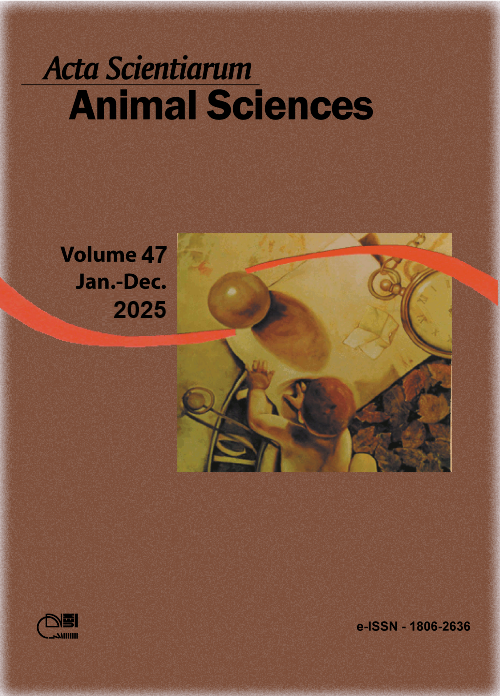Effect of Aroeira (schinus terebinthifolius) leaf essential oils on rumen fermentation, nutrient digestibility, and nitrogen balance in lambs fed with high grain diet
Resumo
Evaluate the effect of Aroeira (Schinus terebinthifolius) leaf essential oils on rumen fermentation parameters, nutrient digestibility, and nitrogen balance in lambs. Treatments were a negative control (CTL - no additives), a positive control (MON - addition of 25 mg of monensin kg-1 of dry matter), doses of 1.25, 2.5, and 3.75 mL of essential oil kg-1 of diet as feed. Thirty crossbred Dorper x Santa Ines lambs with rumen cannulas and weighing 53.08 ± 11.04 kg were assigned to randomized blocks with five replicates per treatment. Across the entire observation period 0, 7, 14, and 21 days the feed additives proved effective in reducing butyrate and increasing ammonia. Linear increase in essential oils on isovalerate. Essential oils exhibited a quadratic effect on acetate, butyrate, C2/C3, and methane (p < 0.05), lower values in treatments at 1.25 and 2.5 mL kg-1. Treatments did not impact with nutrient intake and digestibility. The additives affected the reduction of nitrogen (N) intake and N retained (p < 0.05), Essential oils displayed an effect compared to monensin when decreasing N intake and N retained, with a linear decrease due to the essential oils level when decreasing N intake (p < 0.05). Doses of 1.25, 2.50 mL kg-1 reduced methane production and positively influenced the VFAs.
Downloads
Referências
Abdl-Rahman, M. A. (2010). In vitro manipulation of rumen fermentation efficiency by fumaric acid–bentonite coupled addition as an alternative to antibiotics. The Journal of Agricultural Science, 2(2), 174–180. https://doi.org/10.5539/jas.v2n2p174
Association of Official Analytical Chemists. [AOAC] (1990). Official methods of analysis (15ª ed., Vol. 1).
Association of Official Analytical Chemists. [AOAC] (1997). Official methods of analysis (16ª ed.).
Benchaar, C., Calsamiglia, S., Chaves, A. V., Fraser, G. R., Colombatto, D., McAllister, T. A., & Beauchemin, K. A. (2008). A review of plant-derived essential oils in ruminant nutrition and production. Animal Feed Science and Technology, 145(1-4), 209–228. https://doi.org/10.1016/j.anifeedsci.2007.04.014
Benchaar, C., Chaves, A. V., Fraser, G. R., Beauchemin, K. A., & McAllister, T. A. (2007). Effects of essential oils and their components on in vitro rumen microbial fermentation. Canadian Journal of Animal Science, 87(3), 413–419. https://doi.org/10.4141/cjas07012
Burt, S. (2004). Essential oils: Their antibacterial properties and potential applications in foods—a review. International Journal of Food Microbiology, 94(3), 223–253. https://doi.org/10.1016/j.ijfoodmicro.2004.03.022
Chaney, A. L., & Marbach, E. P. (1962). Modified reagents for determination of urea and ammonia. Clinical Chemistry, 8(2), 130–132.
Cobellis, G., Trabalza-Marinucci, M., Marcotullio, M. C., & Yu, Z. (2016). Evaluation of different essential oils in modulating methane and ammonia production, rumen fermentation, and rumen bacteria in vitro. Animal Feed Science and Technology, 215, 25–36. https://doi.org/10.1016/j.anifeedsci.2016.02.008
Cowan, M. M. (1999). Plant products as antimicrobial agents. Clinical Microbiology Reviews, 12(4), 564–582.
Demirtas, A., Ozturk, H., Sudagidan, M., Keyvan, E., Yavuz, O., Gulay, O. Y., & Musa, S. A. A. (2019). Effects of commercial aldehydes from green leaf volatiles (green odour) on rumen microbial population and fermentation profile in an artificial rumen (Rusitec). Anaerobe, 55, 83–92. https://doi.org/10.1016/j.anaerobe.2018.11.001
diallyl disulfide fail to mitigate methane, but improve digestibility in sheep. Animal Feed Science and Technology, 166–167, 356–363. https://doi.org/10.1016/j.anifeedsci.2011.04.071
Macheboeuf, D., Morgavi, D. P., Papon, Y., Mousset, J. L., & Arturo-Schaan, M. (2008). Dose–response effects of essential oils on in vitro fermentation activity of the rumen microbial population. Animal Feed Science and Technology, 145(1–4), 335–350. https://doi.org/10.1016/j.anifeedsci.2007.05.044
Malecky, M., Broudiscou, L. P., & Schmidely, P. (2009). Effects of two levels of monoterpene blend on rumen fermentation, terpene and nutrient flows in the duodenum, and milk production in dairy goats. Animal Feed Science and Technology, 154(1–2), 24–35. https://doi.org/10.1016/j.anifeedsci.2009.07.004
Martínez, M. J., González, N. A., & Badell, J. B. (1996). Actividad antimicrobiana del Schinus terebenthifolius Raddi (copal). Revista Cubana de Plantas Medicinales, 1(3), 37–39.
Patra, A. K., & Yu, Z. (2012). Effects of essential oils on methane production and fermentation by, and abundance and diversity of, rumen microbial populations. Applied and Environmental Microbiology, 78(12), 4271–4280. https://doi.org/10.1128/AEM.00309-12
Williams, P., & Losa, R. (2010). Effects of addition of an essential oil complex to the diet of lactating dairy cows on whole tract digestion of nutrients and productive performance. Animal Feed Science and Technology, 157(1-2), 64-71. https://doi.org/10.1016/j.anifeedsci.2010.02.001
Statistical Analysis System Institute [SAS]. (2002). SAS system for Windows (Version 9).
Van Soest, P. J., Robertson, J. B., & Lewis, B. A. (1991). Methods for dietary fiber, neutral detergent fiber, and nonstarch polysaccharides in relation to animal nutrition. Journal of Dairy Science, 74(10), 3583–3597. https://doi.org/10.3168/jds.S0022-0302(91)78551-2
DECLARAÇÃO DE ORIGINALIDADE E DIREITOS AUTORAIS
Declaro que o presente artigo é original, não tendo sido submetido à publicação em qualquer outro periódico nacional ou internacional, quer seja em parte ou em sua totalidade.
Os direitos autorais pertencem exclusivamente aos autores. Os direitos de licenciamento utilizados pelo periódico é a licença Creative Commons Attribution 4.0 (CC BY 4.0): são permitidos o compartilhamento (cópia e distribuição do material em qualqer meio ou formato) e adaptação (remix, transformação e criação de material a partir do conteúdo assim licenciado para quaisquer fins, inclusive comerciais.
Recomenda-se a leitura desse link para maiores informações sobre o tema: fornecimento de créditos e referências de forma correta, entre outros detalhes cruciais para uso adequado do material licenciado.








































